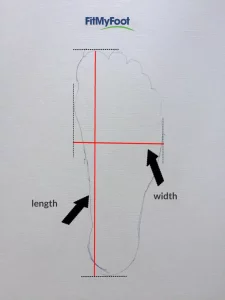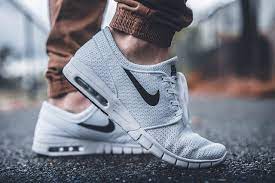How To Decode Shoe Width Size Letters
Shoe sizes can be a confusing and complex topic, especially for those who are not familiar with the various metrics used across different regions and manufacturers. While many people focus on getting the length of their shoes right, it is just as important to consider the width of the shoe to ensure maximum comfort and fit. This is especially important for shoes that are rigid or tight-fitting, or those that will be used for extensive walking or cycling.
Shoes that are too narrow can cause cramps and discomfort, while shoes that are too wide can lead to rubbing and blisters. While it may be possible to adjust the width of some shoes after purchase, it is much easier and more comfortable to find the correct width right from the start.
To determine the width of a shoe, you will need to look for a set of letters that are often displayed alongside the length of the shoe. In the US, there are nine different widths available, each designated by a different combination of letters that indicate whether a shoe is narrow, medium, or wide. However, there are also variations and deviations from this standard that can make things even more confusing.
If you have ever wondered what the various letters and designations on a shoe label mean, this guide is for you. We will explain everything you need to know about how to interpret shoe-width letters and find the perfect fit for your feet. Additionally, if you have wide feet, we recommend checking out our guide on boots specifically designed for wide feet.
What Does Shoe Width Letter (AAA, AA, A, B, C, D, E, EE, and EEE) Mean?
Finding shoe sizes is a maze of numbers and letters for the layman. The U.S. and Europe measure sizes differently, men and women have different size standards, and all manufacturers virtually share no true standard.
However, amidst this chaos of size descriptions, there is another often-overlooked description. That is shoe width. Choosing shoe width is as important for comfort as length.
This is especially important for shoes that are stiff, narrow, and planned to be used extensively for walking, commuting, and cycling. Narrow shoes can compress the foot and cause cramping, while wide shoes can cause friction as the foot moves, which can lead to blisters.
While it may be possible to narrow or widen the width of a shoe after purchase, especially in the case of leather shoes, it is much easier and more comfortable in the long run to decide on a shoe width from the start. The key to determining shoe width is a series of cryptic letters that are usually listed along with the length.
There are nine different shoe widths used in the United States, and the combination of letters can designate narrow, medium, or wide. Of course, there are deviations from this scale if it is not complex enough.
If you have ever wondered what a notation such as b(m) or 2e on a shoe label means, this article is for you. We will teach you all you need to know about how to read the shoe width letters to find the perfect shoe for your foot width.
Standard American shoe width sizes consist of nine unique sizes:
- AAA – Narrowest shoe width size
- AA – More Narrower
- A – Narrow Shoe width size
- B – Medium Width Size
- C – Average Shoe Width Size
- D – Medium size
- E – Wide shoe width Size
- EE – Much Wider Shoe width size
- EEE – Widest shoe width size
 Shoe Width Scale
Shoe Width Scale
In the United States, there are nine different shoe width scales, in order from narrowest to widest: AAA, AA, A, B, C, D, E, EE, and EEE. This scale is somewhat easier to remember because of its alphabetical order, but of course, it is not always obvious at a glance.
Double and triple sizes A and E are often abbreviated as 2a, 3e, and so on. To complicate matters further, some manufacturers have adopted additional designations for oversized shoes, such as 4th and 5th. These unorthodox designations are most often found on men’s boots that are marketed as extra wide.
The physical dimensions represented by the shoe width letter vary depending on the length of the shoe. For example, in men’s shoe sizes, a size 10 D-width shoe may have a width of 10 cm at the ball of the thumb, while the same size 14 D-width shoe may have a width of 10 cm at the same height.
Therefore, if you have to select multiple lengths for the same shoe, you should also check if you need to specify different widths for the two shoe sizes.
-
A-Width
The A width is typically used for women’s shoes that are labeled as suitable for narrow feet. Since relatively few men have such narrow feet, it is rarely used in men’s shoes. A-width shoes are generally 3.4 to 3.9 inches in diameter at the top of the foot.
AA or 2A-width shoes are also commonly used for women and are slightly narrower, but the difference between A and 2A is largely due to manufacturer standards.
-
B width
B width is the standard width for women’s shoes and is considered extremely narrow for men’s shoes. If the width is not specified as wide or narrow in women’s shoes, it is most likely B width. B-width shoes are generally 3.6 to 4.1 inches in diameter at the top of the foot.
-
D width
D width is generally considered medium width for men’s shoes and wide for women’s shoes. For men, shoes that are not labeled “wide” or “narrow” are generally D-width. D-width refers to a width of 3 to 5 inches at the ball of the thumb, but generally 4 to 4.5 inches.
-
E-Width
E-Width is a typical classification of wide shoe size for men and is considered extra wide for women’s shoes. Typically, men’s shoes are between 10 cm and 15 cm at the top of the foot.
-
EE width
EE width, the widest on the conventional scale, is rarely found in women’s shoes and is considered extra-wide in men’s shoes. However, transgender people have created a niche for extra-wide women’s shoes, and many EE-width shoes for women have appeared in recent years. EE-width shoes are generally 4.4 to 4.9 inches wide, but there are also shoes available in 3.4 to 5.4-inch widths.
Manufacturers And Availability
It’s important to keep in mind that every shoe manufacturer uses their own unique model foot when creating and sizing their shoes. This means that shoe width sizing will differ between manufacturers and even between different models of shoes made by the same manufacturer.
Furthermore, how the physical width of a shoe corresponds to a given letter designation can vary depending on the shoe’s make and model. This can make finding the perfect shoe fit a challenging task.
Unfortunately, not all shoes are available in every size and width. People with especially narrow or wide feet may find it difficult to locate shoes that fit well. Sizes such as 2A or narrow and 2E or wider are relatively uncommon and may only be available in shorter or longer lengths.
It’s worth noting that extra wide shoe sizes have traditionally been less available for women’s shoes, while extra narrow shoe sizes have historically been less common for men’s shoes. This can make it especially challenging for those with unique foot shapes to find comfortable shoes that fit properly.
Fitting
The most effective way to determine which shoe width size is appropriate for your feet is by having a shoe professional measure your foot at the store. The sizing scales that are available at shoe stores are generally precise, but it’s important to have your feet measured every time you visit the store as your feet can change size over time due to weight gain or changes in water retention.
It’s also important to try on the same shoe in multiple widths to determine which size works best for your foot in that particular shoe model. A proper fit is crucial for shoes that will be worn for long periods of time, as shoes that are too narrow or too wide can quickly cause discomfort.
However, the shoe width size designations can be confusing and vary between manufacturers, between different shoe models from the same manufacturer, and even between different lengths of the same shoe model. Therefore, it’s essential to try on any pair of shoes to ensure a good fit before making a purchase and to use width sizes as a guide rather than an absolute measurement.
Can Both Women and Men Wear D-Width Shoes?
The width of a shoe is an important factor to consider when buying footwear. A D width shoe is considered medium for men’s shoes, but for women’s shoes, it is considered wide. For example, if you are looking for running shoes for a man with a narrow foot, you may want to consider D-width running shoes for women. While these shoes may be considered narrow for men’s running shoes, they are wide for women’s running shoes.
Conversely, a woman who typically wears wide-width running shoes for women may also find that D-width running shoes for men fit well. It’s important to note that the shoes are simply viewed as wide for female running shoes.
It’s essential to understand different shoe sizing measurements and shoe widths when shopping for shoes online or in stores. This can help you make the right choice and avoid the inconvenience of having to return shoes that don’t fit properly. You can watch informative videos that provide guidance on choosing the right shoe width for both men and women.
Do All Shoe Brands Offer D-Width Shoes?
It can be difficult to find shoes that fit comfortably if you have feet that are wider or narrower than the average shoe size. Unfortunately, not all shoe companies produce shoes in D width, which can be a challenge for some customers. This is because some sneaker brands use their own standards when it comes to shoe length and width measurements.
Typically, most European shoe companies and some US shoe manufacturers only offer standard/medium shoe width measurements. However, in recent times, many popular shoe brands like Clarks, New Balance, ASICS, and others now offer a range of width options for their sneakers, boots, and shoe lines. This means that customers can now choose from a variety of widths ranging from 3A/AAA to 2E/EE, including the D width, which is available in most shoe brands worldwide.
Additional Tips About Shoe Width
For the most accurate measurement of your shoe width, it’s recommended to get your foot measured at a shoe store. However, if you prefer to measure at home, make sure to measure both feet as one foot may be wider or narrower than the other. Additionally, measure your feet later in the day or after activities like walking or working out, as feet tend to swell a bit during the day. This will ensure a more accurate shoe width measurement.
It’s important to note that foot size can change over time due to various factors such as water retention, weight gain, pregnancy, etc. Therefore, it’s essential to regularly measure your feet and not assume your size remains the same throughout your life.
When trying on shoes, it’s recommended to try different styles and brands to find the best fit. Walking or even jumping in the shoes can help you feel how comfortable and supportive they are. Ultimately, you should look for shoes that provide comfort and support to your feet, without constricting them.
What Does Shoe Width (AAA, AA, A, B,C, D,E, EE, and EEE) Mean | Video Explanation

How to find shoes that are the correct width
Numerous studies have revealed that a significant percentage of the population, ranging from 63 percent to 72 percent, are wearing shoes that do not fit them correctly. Wearing shoes that are too tight can lead to various foot problems, so it’s important to find shoes that are the correct width. The following tips can help you in this regard:
- It is important to have your feet measured every time you buy shoes as their shape and size can change over time. Use a soft tape measure to measure the widest part of your foot with your foot flat on the ground.
- Measure your feet at the end of the day when they are at their largest to ensure you don’t underestimate your foot width.
- When trying on shoes, have both feet measured and fit the shoes to your wider foot.
- Don’t rely on shoe size alone as sizes vary among brands and styles. Just because you wear a certain size in one style doesn’t mean that size will fit in another style.
- Don’t expect shoes to stretch out if they don’t fit properly when you try them on. They should fit properly from the beginning to avoid foot problems and pain.
- Stand up and walk around in the shoes when trying them on to allow your foot to spread out under your weight and find shoes that don’t rub or slip.
Common foot problems caused by tight shoes
Wearing shoes that are too tight can have negative consequences on your foot health and may lead to irreversible damage. It is important to wear properly fitting shoes to avoid foot problems such as blisters, calluses, and corns. Shoes that are too tight can also cause foot pain and deformities such as bunions and hammertoes. In severe cases, wearing shoes that are too tight can even cause nerve damage or decrease blood flow to the feet. Therefore, it is essential to pay attention to the fit of your shoes and choose ones that are comfortable and provide adequate support.
Corns and calluses
Wearing tight shoes is a common cause of corns and calluses, which are thick layers of skin that form in response to pressure and friction. Corns are small, circular areas of thick skin that typically develop on the sides or tops of toes. Calluses, on the other hand, are usually larger and form on the bottoms of feet. Although not as painful as corns, calluses can still cause discomfort when they become thick. Corns and calluses develop as a protective reaction of the skin against the pressure caused by tight shoes, as they aim to prevent the skin from getting damaged or blistered.
Ingrown toenails
Ingrown toenails are a painful condition in which the side of the toenail grows into the flesh surrounding it, often occurring in the big toe. This can result in swelling, tenderness, and possible infection. Tight-fitting shoes are a frequent culprit behind ingrown toenails. People with poor blood flow to their feet are at a higher risk of complications due to this condition. It is important to seek treatment for ingrown toenails promptly to prevent complications and ensure proper healing.
Bunions
Bunions are a common foot problem characterized by an enlargement of bones and soft tissues around the joint of the big toe. They usually develop due to wearing tight shoes that squeeze the toes together, causing the big toe to lean toward the second toe.
Over time, the pressure on the joint can cause the bone to stick out, leading to the formation of a bony knob at the base of the big toe. Bunions can grow to a significant size and cause significant pain and discomfort, especially when wearing shoes. This can result in swelling and redness around the affected area. The pain can become so severe that it can affect daily activities such as walking or standing.
Hammer toe
A hammer toe is a foot deformity that causes the toes to bend at the middle joint, affecting mostly the second, third, and fourth toes. The bending of the toe puts pressure on the toe joint and can cause pain, discomfort, and difficulty walking. Additionally, people with hammer toe tend to develop corns and calluses due to the toes rubbing against the top of the shoe. This condition is often caused by wearing tight-fitting shoes that push the toes into a bent position. Without proper treatment, the toe can become permanently fixed, leading to further complications and the need for surgery to correct it.
This passage provides an answer to the question, “What does shoe width E, EE, D, and DD mean?” E width denotes a wide shoe for men and extra wide for women. D width is considered standard for men’s shoes but wide for women’s shoes. The additional letters after E and D indicate an even wider shoe width. EE width means extra wide for men and is wider than E width. However, DD width is not as commonly used. It’s important to understand these shoe width measurements to choose the right shoe size for comfort and support.

Hi, I am Brian, Lives in Mooresville, North Carolina, and Went to The University of Texas at Austin, I am a shoe lover & know the inside out of shoes. I am well aware of the qualities of top-quality boots. That’s what I’m sharing with the reader of About Shoes/boots/footwear. Read More Here
 Shoe Width Scale
Shoe Width Scale A-Width
A-Width

